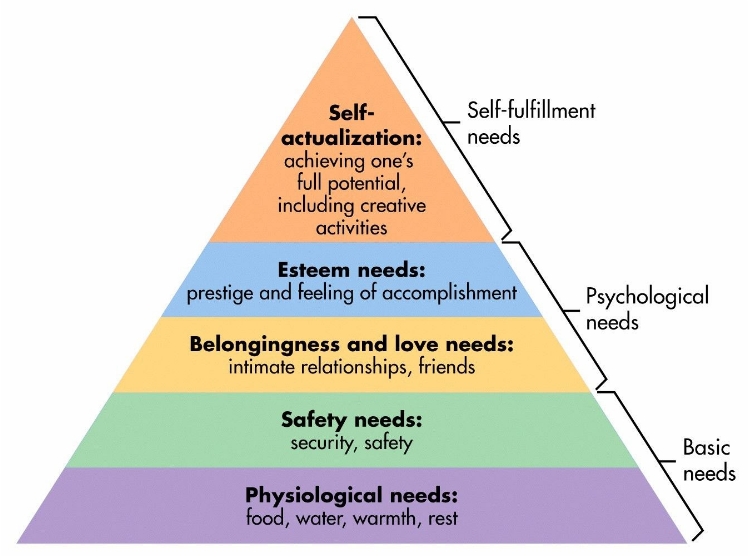Abraham Maslow developed the hierarchy of needs summarised in the illustration above. Can it help in the design of safe experiments?
His framework provides a motivational theory in psychology. It comprises a five-tier model of human needs, often depicted as hierarchical levels within a pyramid:
- from physiological needs for food and clothing, on to
- safety (job security), and
- beyond, to belonging (friendship),
- toward esteem needs, and
- to fulfilment through self-actualization.
On the surface, it all seems rather attractive – simple and to the point. I’m not going into the detail of this pyramid as it is well explained on the internet; try this lead.
Can Maslow direct our attention to safe experiments?
The key task I want to address is whether this well-established visual aid can help us with small, safe experiments. The diagram, above, does go some way to explain the implications that arise when crises disrupt the therapy process.
It is difficult to make planned changes in our lives when there is urgency about the absence of basic needs we have for shelter and security.
The downside of the Maslow’s hierarchy – a product of its time – is that it shares the same problems as other, older ‘stage’ models of more traditional human growth and development.
These models seem to be built on implicit value judgements; any hierarchy implies there are the few, and there are the many; self-actualisation is attained by the few. Most of us cannot move on until basic needs are met. In modern psychology, most models with rigid boundaries are seen as less helpful. They offer a flawed view on the ‘real world’. Maslow, as with other hierarchical models, tends to problematise things. More troubling, the pyramid is built on an implicit tendency to value one thing, over another. There is an oft-unaddressed judgement that some people are better off than others. Our job in life is to strive and to climb up into the ‘higher’ levels.
Despite this, there are ample examples of individuals demonstrating ‘self-actualisation’ without all the trapping of ‘accomplishment’. The ‘ladder’ implies that possessing self-actualisation, for example, is more valued than than just getting by – having our immediate needs met.
Updating Maslow in the 21st century
Despite my atheistic background, I am reminded of Jesus’ point from the Sermon on the Mount:
“Behold the fowls of the air: for they sow not, neither do they reap, nor gather into barns; yet your heavenly Father feedeth them. Are ye not much better than they?”
For my part, I find the implicit oppressiveness in Maslow’s model overlooks some rather important structural inequalities in our world – East or West. It is one thing to identify what needs humans have, and it is another thing to down-play how those needs are to be met.
So, am I on a ‘rant’ here, or can the design of safe experiments be helped by Maslow’s Hierarchy? There are valued ways it helps, and I’d still ask you to keep in mind an alternative perspective I have painted on this page. With that said, let’s look a bit further at:
SOME SAFE EXPERIMENTS
Take time to reflect on your priorities in life. Can you use your wisdom to identify your priorities and define your own ‘hierarchy’? Any paper-and-pen exercise can help. Not just listing things, but drawing and doodling helps some people.
Use your notes to develop safe experiments such as:
- what does your physiological provision – of food and clothing – look like. Are there dietary habits that you may want to change. Explore solution-focused outlooks to identify practical ways to negotiate with other people in your life.
- what does ‘safety in home and work’ look like for you. Can you give time to reflecting on these issues and slowing yourself down. Will this minimise the prospect of tripping over yourself! Controlled breathing and meditation works for some people here.
- what are your love and belonging needs (friendship): consider the three-circle model of Compassion-focused work, as well as the safe experiments that come out of transactional analysis (TA).This model is particularly relevant when your experiments attend to the way you communicate with other people in your life.
- can you improve your own self-esteem through structured adult education such as assertiveness and mindfulness programmes. Affirmation work may be relevant, alongside work on affect regulation and specific feelings such as anger, and
- self-actualization, where the focus is on improved awareness of who you are, where you are and how you are being.
- Changing the direction in your lifetime scenic route. It is easy to go on doing the same old things. You do not have live like Sisyphus, see the page on looping. Your Script can be altered. Film makers do it with books all the time!
This brief entry contains a number of hyper-links offering you a range of possible safe experiments. They are just suggestions and possibilities.
The outcomes that emerge from steps you take are more important than the examples I have on offer here.
